This lecture is about whether we can predict the future, or whether it is arbitrary and random. In ancient times, the world must have seemed pretty arbitrary. Disasters such as floods or diseases must have seemed to happen without warning, or apparent reason. Primitive people attributed such natural phenomena, to a pantheon of gods and goddesses, who behaved in a capricious and whimsical way. There was no way to predict what they would do, and the only hope was to win favor by gifts or actions. Many people still partially subscribe to this belief, and try to make a pact with fortune. They offer to do certain things, if only they can get an A-grade for a course, or pass their driving test.
Gradually however, people must have noticed certain regularities in the behavior of nature. These regularities were most obvious, in the motion of the heavenly bodies across the sky. So astronomy was the first science to be developed. It was put on a firm mathematical basis by Newton, more than 300 years ago, and we still use his theory of gravity to predict the motion of almost all celestial bodies. Following the example of astronomy, it was found that other natural phenomena also obeyed definite scientific laws. This led to the idea of scientific determinism, which seems first to have been publicly expressed by the French scientist, Laplace. I thought I would like to quote you Laplace's actual words, so I asked a friend to track them down. They are in French of course, not that I expect that would be any problem with this audience. But the trouble is, Laplace was rather like Prewst, in that he wrote sentences of inordinate length and complexity. So I have decided to para-phrase the quotation. In effect what he said was, that if at one time, we knew the positions and speeds of all the particles in the universe, then we could calculate their behavior at any other time, in the past or future. There is a probably apocryphal story, that when Laplace was asked by Napoleon, how God fitted into this system, he replied, 'Sire, I have not needed that hypothesis.' I don't think that Laplace was claiming that God didn't exist. It is just that He doesn't intervene, to break the laws of Science. That must be the position of every scientist. A scientific law, is not a scientific law, if it only holds when some supernatural being, decides to let things run, and not intervene.
The idea that the state of the universe at one time determines the state at all other times, has been a central tenet of science, ever since Laplace's time. It implies that we can predict the future, in principle at least.
 In practice,
however, our ability to predict the future is severely limited by the complexity of the
equations, and the fact that they often have a property called chaos. As those who have
seen Jurassic Park will know, this means a tiny disturbance in one place, can cause a
major change in another. A butterfly flapping its wings can cause rain in Central Park,
New York. The trouble is, it is not repeatable. The next time the butterfly flaps its
wings, a host of other things will be different, which will also influence the weather.
That is why weather forecasts are so unreliable.
In practice,
however, our ability to predict the future is severely limited by the complexity of the
equations, and the fact that they often have a property called chaos. As those who have
seen Jurassic Park will know, this means a tiny disturbance in one place, can cause a
major change in another. A butterfly flapping its wings can cause rain in Central Park,
New York. The trouble is, it is not repeatable. The next time the butterfly flaps its
wings, a host of other things will be different, which will also influence the weather.
That is why weather forecasts are so unreliable. Despite these practical difficulties, scientific determinism, remained the official dogma throughout the 19th century. However, in the 20th century, there have been two developments that show that Laplace's vision, of a complete prediction of the future, can not be realized. The first of these developments was what is called, quantum mechanics. This was first put forward in 1900, by the German physicist, Max Planck, as an ad hoc hypothesis, to solve an outstanding paradox. According to the classical 19th century ideas, dating back to Laplace, a hot body, like a piece of red hot metal, should give off radiation.
 It would lose energy in radio
waves, infra red, visible light, ultra violet, x-rays, and gamma rays, all at the same
rate. Not only would this mean that we would all die of skin cancer, but also everything
in the universe would be at the same temperature, which clearly it isn't. However, Planck
showed one could avoid this disaster, if one gave up the idea that the amount of radiation
could have just any value, and said instead that radiation came only in packets or quanta
of a certain size. It is a bit like saying that you can't buy sugar loose in the
supermarket, but only in kilogram bags. The energy in the packets or quanta, is higher for
ultra violet and x-rays, than for infra red or visible light. This means that unless a
body is very hot, like the Sun, it will not have enough energy, to give off even a single
quantum of ultra violet or x-rays. That is why we don't get sunburn from a cup of coffee.
It would lose energy in radio
waves, infra red, visible light, ultra violet, x-rays, and gamma rays, all at the same
rate. Not only would this mean that we would all die of skin cancer, but also everything
in the universe would be at the same temperature, which clearly it isn't. However, Planck
showed one could avoid this disaster, if one gave up the idea that the amount of radiation
could have just any value, and said instead that radiation came only in packets or quanta
of a certain size. It is a bit like saying that you can't buy sugar loose in the
supermarket, but only in kilogram bags. The energy in the packets or quanta, is higher for
ultra violet and x-rays, than for infra red or visible light. This means that unless a
body is very hot, like the Sun, it will not have enough energy, to give off even a single
quantum of ultra violet or x-rays. That is why we don't get sunburn from a cup of coffee. Planck regarded the idea of quanta, as just a mathematical trick, and not as having any physical reality, whatever that might mean. However, physicists began to find other behavior, that could be explained only in terms of quantities having discrete, or quantized values, rather than continuously variable ones. For example, it was found that elementary particles behaved rather like little tops, spinning about an axis. But the amount of spin couldn't have just any value. It had to be some multiple of a basic unit. Because this unit is very small, one does not notice that a normal top really slows down in a rapid sequence of discrete steps, rather than as a continuous process. But for tops as small as atoms, the discrete nature of spin is very important.
It was some time before people realized the implications of this quantum behavior for determinism. It was not until 1926, that Werner Heisenberg, another German physicist, pointed out that you couldn't measure both the position, and the speed, of a particle exactly. To see where a particle is, one has to shine light on it. But by Planck's work, one can't use an arbitrarily small amount of light.
 One has to use at least one quantum.
This will disturb the particle, and change its speed in a way that can't be predicted. To
measure the position of the particle accurately, you will have to use light of short wave
length, like ultra violet, x-rays, or gamma rays. But again, by Planck's work, quanta of
these forms of light have higher energies than those of visible light. So they will
disturb the speed of the particle more. It is a no win situation: the more accurately you
try to measure the position of the particle, the less accurately you can know the speed,
and vice versa. This is summed up in the Uncertainty Principle that Heisenberg formulated;
the uncertainty in the position of a particle, times the uncertainty in its speed, is
always greater than a quantity called Planck's constant, divided by the mass of the
particle.
One has to use at least one quantum.
This will disturb the particle, and change its speed in a way that can't be predicted. To
measure the position of the particle accurately, you will have to use light of short wave
length, like ultra violet, x-rays, or gamma rays. But again, by Planck's work, quanta of
these forms of light have higher energies than those of visible light. So they will
disturb the speed of the particle more. It is a no win situation: the more accurately you
try to measure the position of the particle, the less accurately you can know the speed,
and vice versa. This is summed up in the Uncertainty Principle that Heisenberg formulated;
the uncertainty in the position of a particle, times the uncertainty in its speed, is
always greater than a quantity called Planck's constant, divided by the mass of the
particle. Laplace's vision, of scientific determinism, involved knowing the positions and speeds of the particles in the universe, at one instant of time. So it was seriously undermined by Heisenberg's Uncertainty principle. How could one predict the future, when one could not measure accurately both the positions, and the speeds, of particles at the present time? No matter how powerful a computer you have, if you put lousy data in, you will get lousy predictions out.
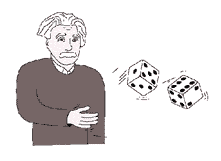 Einstein was very unhappy about this apparent
randomness in nature. His views were summed up in his famous phrase, 'God does not play
dice'. He seemed to have felt that the uncertainty was only provisional: but that there
was an underlying reality, in which particles would have well defined positions and
speeds, and would evolve according to deterministic laws, in the spirit of Laplace. This
reality might be known to God, but the quantum nature of light would prevent us seeing it,
except through a glass darkly.
Einstein was very unhappy about this apparent
randomness in nature. His views were summed up in his famous phrase, 'God does not play
dice'. He seemed to have felt that the uncertainty was only provisional: but that there
was an underlying reality, in which particles would have well defined positions and
speeds, and would evolve according to deterministic laws, in the spirit of Laplace. This
reality might be known to God, but the quantum nature of light would prevent us seeing it,
except through a glass darkly. Einstein's view was what would now be called, a hidden variable theory. Hidden variable theories might seem to be the most obvious way to incorporate the Uncertainty Principle into physics. They form the basis of the mental picture of the universe, held by many scientists, and almost all philosophers of science. But these hidden variable theories are wrong. The British physicist, John Bell, who died recently, devised an experimental test that would distinguish hidden variable theories. When the experiment was carried out carefully, the results were inconsistent with hidden variables. Thus it seems that even God is bound by the Uncertainty Principle, and can not know both the position, and the speed, of a particle. So God does play dice with the universe. All the evidence points to him being an inveterate gambler, who throws the dice on every possible occasion.
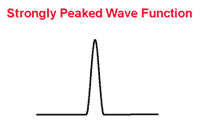 Other scientists were much more ready than
Einstein to modify the classical 19th century view of determinism. A new theory, called
quantum mechanics, was put forward by Heisenberg, the Austrian, Erwin Schroedinger, and
the British physicist, Paul Dirac. Dirac was my predecessor but one, as the Lucasian
Professor in Cambridge. Although quantum mechanics has been around for nearly 70 years, it
is still not generally understood or appreciated, even by those that use it to do
calculations. Yet it should concern us all, because it is a completely different picture
of the physical universe, and of reality itself. In quantum mechanics, particles don't
have well defined positions and speeds.
Other scientists were much more ready than
Einstein to modify the classical 19th century view of determinism. A new theory, called
quantum mechanics, was put forward by Heisenberg, the Austrian, Erwin Schroedinger, and
the British physicist, Paul Dirac. Dirac was my predecessor but one, as the Lucasian
Professor in Cambridge. Although quantum mechanics has been around for nearly 70 years, it
is still not generally understood or appreciated, even by those that use it to do
calculations. Yet it should concern us all, because it is a completely different picture
of the physical universe, and of reality itself. In quantum mechanics, particles don't
have well defined positions and speeds. 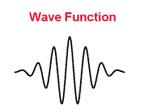 Instead, they are represented by what is
called a wave function. This is a number at each point of space. The size of the wave
function gives the probability that the particle will be found in that position. The rate,
at which the wave function varies from point to point, gives the speed of the particle.
One can have a wave function that is very strongly peaked in a small region. This will
mean that the uncertainty in the position is small. But the wave function will vary very
rapidly near the peak, up on one side, and down on the other. Thus the uncertainty in the
speed will be large. Similarly, one can have wave functions where the uncertainty in the
speed is small, but the uncertainty in the position is large.
Instead, they are represented by what is
called a wave function. This is a number at each point of space. The size of the wave
function gives the probability that the particle will be found in that position. The rate,
at which the wave function varies from point to point, gives the speed of the particle.
One can have a wave function that is very strongly peaked in a small region. This will
mean that the uncertainty in the position is small. But the wave function will vary very
rapidly near the peak, up on one side, and down on the other. Thus the uncertainty in the
speed will be large. Similarly, one can have wave functions where the uncertainty in the
speed is small, but the uncertainty in the position is large. The wave function contains all that one can know of the particle, both its position, and its speed. If you know the wave function at one time, then its values at other times are determined by what is called the Schroedinger equation. Thus one still has a kind of determinism, but it is not the sort that Laplace envisaged. Instead of being able to predict the positions and speeds of particles, all we can predict is the wave function. This means that we can predict just half what we could, according to the classical 19th century view.
Although quantum mechanics leads to uncertainty, when we try to predict both the position and the speed, it still allows us to predict, with certainty, one combination of position and speed. However, even this degree of certainty, seems to be threatened by more recent developments. The problem arises because gravity can warp space-time so much, that there can be regions that we don't observe.
Interestingly enough, Laplace himself wrote a paper in 1799 on how some stars could have a gravitational field so strong that light could not escape, but would be dragged back onto the star. He even calculated that a star of the same density as the Sun, but two hundred and fifty times the size, would have this property. But although Laplace may not have realized it, the same idea had been put forward 16 years earlier by a Cambridge man, John Mitchell, in a paper in the Philosophical Transactions of the Royal Society. Both Mitchell and Laplace thought of light as consisting of particles, rather like cannon balls, that could be slowed down by gravity, and made to fall back on the star. But a famous experiment, carried out by two Americans, Michelson and Morley in 1887, showed that light always traveled at a speed of one hundred and eighty six thousand miles a second, no matter where it came from. How then could gravity slow down light, and make it fall back.
This was impossible, according to the then accepted ideas of
space and time. But in 1915, Einstein put forward his revolutionary General Theory of
Relativity. In this, space and time were no longer separate and independent entities.
Instead, they were just different directions in a single object called space-time. This
space-time was not flat, but was warped and curved by the matter and energy in it. 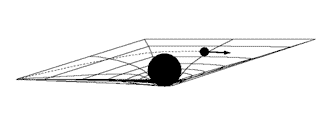 In order to understand this, considered a sheet
of rubber, with a weight placed on it, to represent a star. The weight will form a
depression in the rubber, and will cause the sheet near the star to be curved, rather than
flat. If one now rolls marbles on the rubber sheet, their paths will be curved, rather
than being straight lines. In 1919, a British expedition to West Africa, looked at light
from distant stars, that passed near the Sun during an eclipse. They found that the images
of the stars were shifted slightly from their normal positions. This indicated that the
paths of the light from the stars had been bent by the curved space-time near the Sun.
General Relativity was confirmed.
In order to understand this, considered a sheet
of rubber, with a weight placed on it, to represent a star. The weight will form a
depression in the rubber, and will cause the sheet near the star to be curved, rather than
flat. If one now rolls marbles on the rubber sheet, their paths will be curved, rather
than being straight lines. In 1919, a British expedition to West Africa, looked at light
from distant stars, that passed near the Sun during an eclipse. They found that the images
of the stars were shifted slightly from their normal positions. This indicated that the
paths of the light from the stars had been bent by the curved space-time near the Sun.
General Relativity was confirmed.
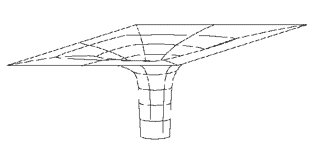 Consider now placing heavier and heavier, and more
and more concentrated weights on the rubber sheet. They will depress the sheet more and
more. Eventually, at a critical weight and size, they will make a bottomless hole in the
sheet, which particles can fall into, but nothing can get out of.
Consider now placing heavier and heavier, and more
and more concentrated weights on the rubber sheet. They will depress the sheet more and
more. Eventually, at a critical weight and size, they will make a bottomless hole in the
sheet, which particles can fall into, but nothing can get out of.
What happens in space-time according to General Relativity is rather similar. A star will
curve and distort the space-time near it, more and more, the more massive and more compact
the star is. If a massive star, which has burnt up its nuclear fuel, cools and shrinks
below a critical size, it will quite literally make a bottomless hole in space-time, that
light can't get out of. Such objects were given the name Black Holes, by the American
physicist John Wheeler, who was one of the first to recognize their importance, and the
problems they pose. The name caught on quickly. To Americans, it suggested something dark
and mysterious, while to the British, there was the added resonance of the Black Hole of
Calcutta. But the French, being French, saw a more risqué meaning. For years, they
resisted the name, trou noir, claiming it was obscene. But that was a bit like trying to
stand against le weekend, and other franglais. In the end, they had to give in. Who can
resist a name that is such a winner?
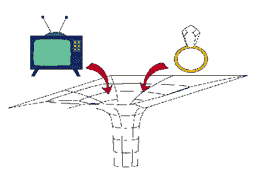 We now have observations that point to
black holes in a number of objects, from binary star systems, to the center of galaxies.
So it is now generally accepted that black holes exist. But, apart from their potential
for science fiction, what is their significance for determinism. The answer lies in a
bumper sticker that I used to have on the door of my office: Black Holes are Out of Sight.
Not only do the particles and unlucky astronauts that fall into a black hole, never come
out again, but also the information that they carry, is lost forever, at least from our
region of the universe. You can throw television sets, diamond rings, or even your worst
enemies into a black hole, and all the black hole will remember, is the total mass, and
the state of rotation. John Wheeler called this, 'A Black Hole Has No Hair.' To the
French, this just confirmed their suspicions.
We now have observations that point to
black holes in a number of objects, from binary star systems, to the center of galaxies.
So it is now generally accepted that black holes exist. But, apart from their potential
for science fiction, what is their significance for determinism. The answer lies in a
bumper sticker that I used to have on the door of my office: Black Holes are Out of Sight.
Not only do the particles and unlucky astronauts that fall into a black hole, never come
out again, but also the information that they carry, is lost forever, at least from our
region of the universe. You can throw television sets, diamond rings, or even your worst
enemies into a black hole, and all the black hole will remember, is the total mass, and
the state of rotation. John Wheeler called this, 'A Black Hole Has No Hair.' To the
French, this just confirmed their suspicions.
As long as it was thought that black holes would continue to exist forever, this loss of
information didn't seem to matter too much. One could say that the information still
existed inside the black hole. 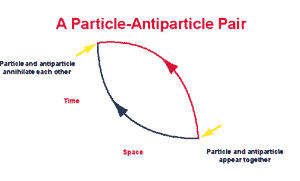 It is just that one can't tell what it is,
from the outside. However, the situation changed, when I discovered that black holes
aren't completely black. Quantum mechanics causes them to send out particles and radiation
at a steady rate. This result came as a total surprise to me, and everyone else. But with
hindsight, it should have been obvious. What we think of as empty space is not really
empty, but it is filled with pairs of particles and anti particles. These appear together
at some point of space and time, move apart, and then come together and annihilate each
other. These particles and anti particles occur because a field, such as the fields that
carry light and gravity, can't be exactly zero. That would mean that the value of the
field, would have both an exact position (at zero), and an exact speed or rate of change
(also zero). This would be against the Uncertainty Principle, just as a particle can't
have both an exact position, and an exact speed. So all fields must have what are called,
vacuum fluctuations. Because of the quantum behavior of nature, one can interpret these
vacuum fluctuations, in terms of particles and anti particles, as I have described.
It is just that one can't tell what it is,
from the outside. However, the situation changed, when I discovered that black holes
aren't completely black. Quantum mechanics causes them to send out particles and radiation
at a steady rate. This result came as a total surprise to me, and everyone else. But with
hindsight, it should have been obvious. What we think of as empty space is not really
empty, but it is filled with pairs of particles and anti particles. These appear together
at some point of space and time, move apart, and then come together and annihilate each
other. These particles and anti particles occur because a field, such as the fields that
carry light and gravity, can't be exactly zero. That would mean that the value of the
field, would have both an exact position (at zero), and an exact speed or rate of change
(also zero). This would be against the Uncertainty Principle, just as a particle can't
have both an exact position, and an exact speed. So all fields must have what are called,
vacuum fluctuations. Because of the quantum behavior of nature, one can interpret these
vacuum fluctuations, in terms of particles and anti particles, as I have described.
These pairs of particles occur for all varieties of elementary particles. They are called
virtual particles, because they occur even in the vacuum, and they can't be directly
measured by particle detectors. However, the indirect effects of virtual particles, or
vacuum fluctuations, have been observed in a number of experiments, and their existence
confirmed.
 If there is a black hole around,
one member of a particle anti particle pair may fall into the hole, leaving the other
member without a partner, with which to annihilate. The forsaken particle may fall into
the hole as well, but it may also escape to a large distance from the hole, where it will
become a real particle, that can be measured by a particle detector. To someone a long way
from the black hole, it will appear to have been emitted by the hole.
If there is a black hole around,
one member of a particle anti particle pair may fall into the hole, leaving the other
member without a partner, with which to annihilate. The forsaken particle may fall into
the hole as well, but it may also escape to a large distance from the hole, where it will
become a real particle, that can be measured by a particle detector. To someone a long way
from the black hole, it will appear to have been emitted by the hole.
This explanation of how black holes ain't so black, makes it clear that the emission will
depend on the size of the black hole, and the rate at which it is rotating. But because
black holes have no hair, in Wheeler's phrase, the radiation will be otherwise independent
of what went into the hole. It doesn't matter whether you throw television sets, diamond
rings, or your worst enemies, into a black hole. What comes back out will be the same.
So what has all this to do with determinism, which is what this lecture is supposed to be
about. What it shows is that there are many initial states, containing television sets,
diamond rings, and even people, that evolve to the same final state, at least outside the
black hole. But in Laplace's picture of determinism, there was a one to one correspondence
between initial states, and final states. If you knew the state of the universe at some
time in the past, you could predict it in the future. Similarly, if you knew it in the
future, you could calculate what it must have been in the past. The advent of quantum
theory in the 1920s reduced the amount one could predict by half, but it still left a one
to one correspondence between the states of the universe at different times. If one knew
the wave function at one time, one could calculate it at any other time.
With black holes, however, the situation is rather different. One will end up with the
same state outside the hole, whatever one threw in, provided it has the same mass. Thus
there is not a one to one correspondence between the initial state, and the final state
outside the black hole. There will be a one to one correspondence between the initial
state, and the final state both outside, and inside, the black hole. But the important
point is that the emission of particles, and radiation by the black hole, will cause the
hole to lose mass, and get smaller. Eventually, it seems the black hole will get down to
zero mass, and will disappear altogether. What then will happen to all the objects that
fell into the hole, and all the people that either jumped in, or were pushed? They can't
come out again, because there isn't enough mass or energy left in the black hole, to send
them out again. They may pass into another universe, but that is not something that will
make any difference, to those of us prudent enough not to jump into a black hole. Even the
information, about what fell into the hole, could not come out again when the hole finally
disappears. Information can not be carried free, as those of you with phone bills will
know. Information requires energy to carry it, and there won't be enough energy left when
the black hole disappears.
What all this means is, that information will be lost from our region of the universe,
when black holes are formed, and then evaporate. This loss of information will mean that
we can predict even less than we thought, on the basis of quantum theory. In quantum
theory, one may not be able to predict with certainty, both the position, and the speed of
a particle. But there is still one combination of position and speed that can be
predicted. 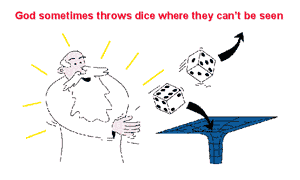 In the case of a black hole, this
definite prediction involves both members of a particle pair. But we can measure only the
particle that comes out. There's no way even in principle that we can measure the particle
that falls into the hole. So, for all we can tell, it could be in any state. This means we
can not make any definite prediction, about the particle that escapes from the hole. We
can calculate the probability that the particle has this or that position, or speed. But
there's no combination of the position and speed of just one particle that we can
definitely predict, because the speed and position will depend on the other particle,
which we don't observe. Thus it seems Einstein was doubly wrong when he said, God does not
play dice. Not only does God definitely play dice, but He sometimes confuses us by
throwing them where they can't be seen.
In the case of a black hole, this
definite prediction involves both members of a particle pair. But we can measure only the
particle that comes out. There's no way even in principle that we can measure the particle
that falls into the hole. So, for all we can tell, it could be in any state. This means we
can not make any definite prediction, about the particle that escapes from the hole. We
can calculate the probability that the particle has this or that position, or speed. But
there's no combination of the position and speed of just one particle that we can
definitely predict, because the speed and position will depend on the other particle,
which we don't observe. Thus it seems Einstein was doubly wrong when he said, God does not
play dice. Not only does God definitely play dice, but He sometimes confuses us by
throwing them where they can't be seen.
Many scientists are like Einstein, in that they have a deep emotional attachment to
determinism. Unlike Einstein, they have accepted the reduction in our ability to predict,
that quantum theory brought about. But that was far enough. They didn't like the further
reduction, which black holes seemed to imply. They have therefore claimed that information
is not really lost down black holes. But they have not managed to find any mechanism that
would return the information. It is just a pious hope that the universe is deterministic,
in the way that Laplace thought. I feel these scientists have not learnt the lesson of
history. The universe does not behave according to our pre-conceived ideas. It continues
to surprise us.
One might not think it mattered very much, if determinism broke down near black holes. We
are almost certainly at least a few light years, from a black hole of any size. But, the
Uncertainty Principle implies that every region of space should be full of tiny virtual
black holes, which appear and disappear again. One would think that particles and
information could fall into these black holes, and be lost. Because these virtual black
holes are so small, a hundred billion billion times smaller than the nucleus of an atom,
the rate at which information would be lost would be very low. That is why the laws of
science appear deterministic, to a very good approximation. But in extreme conditions,
like in the early universe, or in high energy particle collisions, there could be
significant loss of information. This would lead to unpredictability, in the evolution of
the universe.
To sum up, what I have been talking about, is whether the universe evolves in an arbitrary
way, or whether it is deterministic. The classical view, put forward by Laplace, was that
the future motion of particles was completely determined, if one knew their positions and
speeds at one time. This view had to be modified, when Heisenberg put forward his
Uncertainty Principle, which said that one could not know both the position, and the
speed, accurately. However, it was still possible to predict one combination of position
and speed. But even this limited predictability disappeared, when the effects of black
holes were taken into account. The loss of particles and information down black holes
meant that the particles that came out were random. One could calculate probabilities, but
one could not make any definite predictions. Thus, the future of the universe is not
completely determined by the laws of science, and its present state, as Laplace thought.
God still has a few tricks up his sleeve.
That is all I have to say for the moment. Thank you for listening.